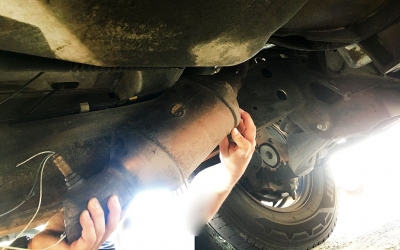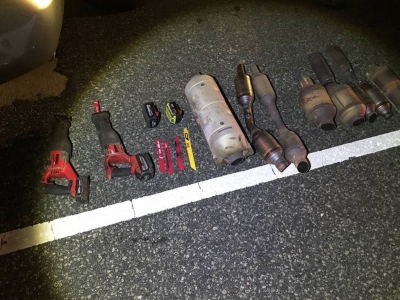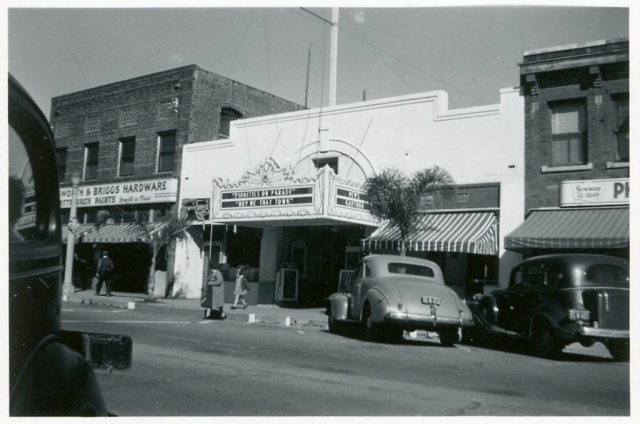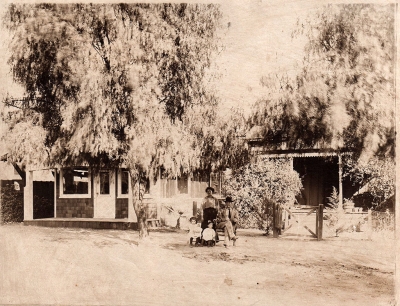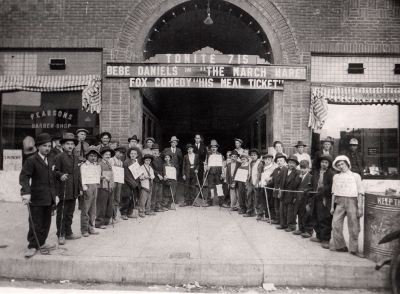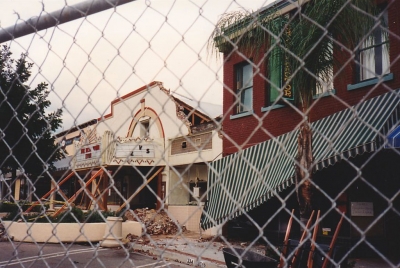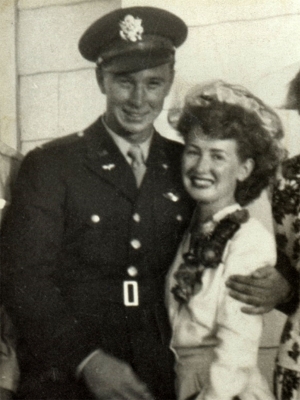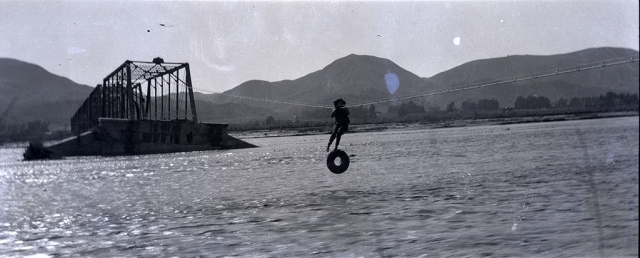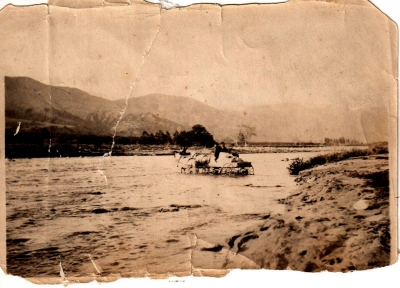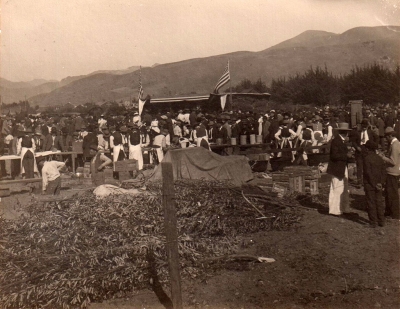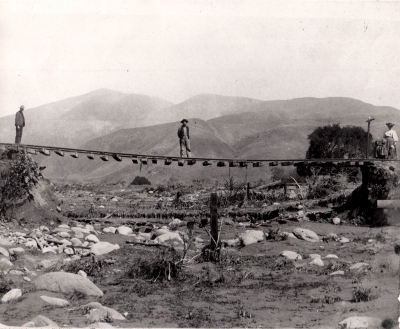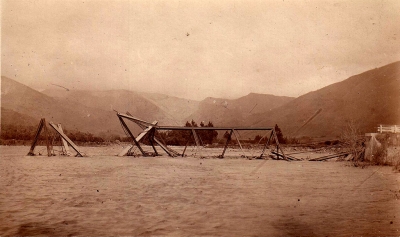|
By Anonymous — Wednesday, January 20th, 2021
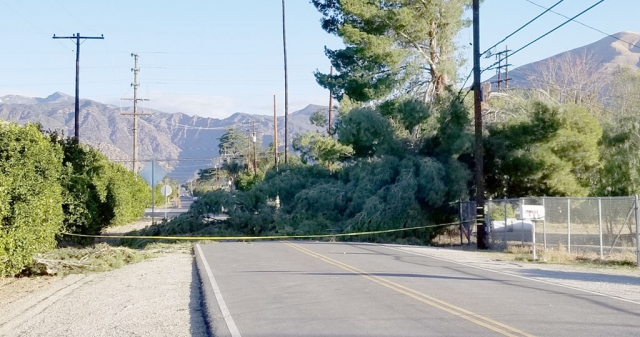 On Wednesday morning, January 20th Grand Avenue in the Fillmore was blocked off by a large tree taken down by the powerful Santa Ana winds. Enlarge Photo |
|
By Anonymous — Wednesday, January 20th, 2021
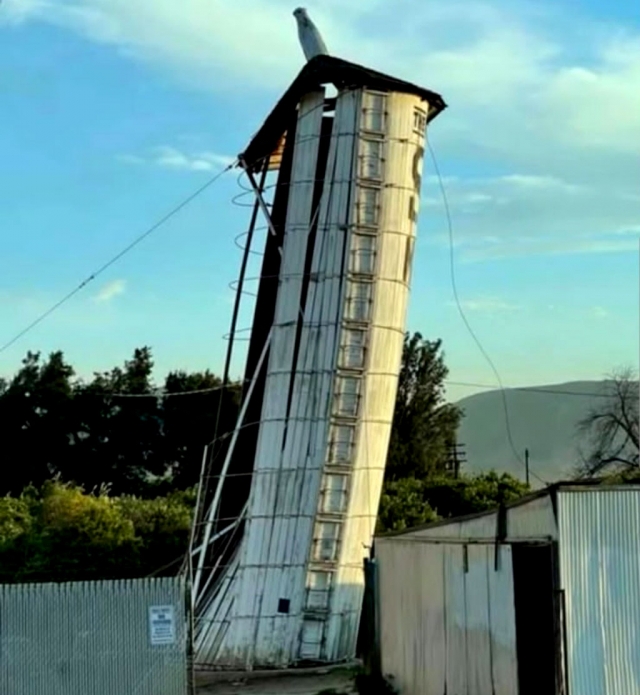 Gusty winds were not kind in Fillmore this past week. On Tuesday, January 19th the wind caused damages to the Sanitary Dairy which sits on Old Telegraph road in Fillmore is a historic national landmark in 1989 by the Ventura County Board of Supervisors. Enlarge Photo |
|
By Ventura County Sheriff Department — Wednesday, January 20th, 2021
Catalytic converter thefts are on the rise statewide. The Ventura County Sheriff’s Office is reminding the public to be aware and consider taking simple precautions that could help safeguard their vehicles from this and other types of crime. Your vehicle’s catalytic converter is a device used to reduce toxicity of emissions from an internal combustion engine. It is required by law on every motor vehicle operated in the United States since 1975. It is attached to your exhaust system underneath your car. Catalytic converters contain expensive precious metals like platinum, palladium and rhodium. These recyclable materials can be easily “scrapped” for a quick profit. Thieves usually commit these crimes in the early morning hours, often targeting trucks or SUVs because the higher ground clearance allows easier access underneath the vehicle. However, sports cars and sedans may also be targeted. The most common vehicles targeted are 1999-2003 Ford F/E series 250 and 350 vehicles, Toyota Prius, Honda Element, Honda Accord, and older model Jeep Cherokee SUV’s. WHAT CAN YOU DO TO PROTECT YOUR VEHICLE? Help us to deter this and other crimes. Be alert and aware while in parking lots, on roadways and in your neighborhood. Report suspicious activity by calling the Ventura County Sheriff's non-emergency number at 805-654-9511. If you see a crime in progress, call 9-1-1. Prepared by: Sergeant Victor Medina |
|
By Anonymous — Wednesday, January 20th, 2021
Courtesy Fillmore Historical Museum In January 1912, the citizens of Fillmore waited impatiently to find out who would win the contest to name the new moving picture theatre opening on Central Avenue. The winner would receive a coveted six month pass to theatre. The manager of the theatre, Merton Barnes, had been overwhelmed by entries. Some of them included “Fillmorine” (Elsie Sallee), “El Favorito” (E. A. Pyle), and “Citrus Valley Opera House” (Mrs. L. Snow). The winner was decided by a group of Fillmore luminaries, F. L. Fairbanks W. E. McCampbell, and John B. McNab. The winner entry was “The Empire” with Ralph Guerrant winning the pass. This theatre was in the Brinley Building, where 341/343 Central would be in 2021. The manager, Merton Barnes, had been in theatre stock companies traveling around the United States before coming to Fillmore and opening The Empire. Besides managing the theatre, in 1912 he was chosen as the Judge for Fillmore township and would serve as Judge for the City of Fillmore until 1928. He also coined the promotional slogan, “Fortune Favored Fillmore.” The Empire Theatre operated until 1916 presenting a mixture of movies, vaudeville acts, and speakers on a variety of subjects. In 1916, Leon Hammond built a commercial building where his home had previously stood. He was the son of a British surgeon and French mother and had arrived in Fillmore about 1905. His father served in the Confederate Army in the “War Between the States” and later emigrated to Brazil where Leon was born. They returned to the United States when Leon was a young child. The building Hammond built was to Merton Barnes’ specifications. According to his daughter, Barbara Barnes Jones, the stage was very modern with its equipment for scenery, a large door at the rear to bring scenery in and out and a trap door on stage. It had an orchestra pit which was later taken over by a large electric organ played by Mr. Sallee, Barbara Barnes or Pauline Irwin. There was also a steep pitch to the seating area about 5 feet, unusual for the time. There was a large lobby which had large picture frames in which photos of coming events were placed. Colors of cream and soft green were selected for the interior. As with the Empire, this was a multiuse facility. Besides motion pictures there were piano recitals, plays, public lectures and “Country Store” nights when groceries were given away at the movies. On November 2, 1917, there was a “RAH, RAH” night for high school students. According to the paper, students held a rally in front of the Barnes Theatre to boost the Fillmore-Ventura football game to be held the next day. Afterward they were guests of Judge Barnes at the Theatre. Mr. and Mrs. Richard Stephens hosted all the town’s children to a special Christmas movie, a tradition they had begun in 1912 at the Empire Theatre. In April 1920, to please the public, Judge Barnes ran a coupon in the paper asking people to send in their preferred time for weekday shows. Merton Barnes sold the theatre in October 1926, to H. C. Stearns and the name of the theatre was changed to the Stearns Theatre. In 1930, Mr. Stearns added the new marquee changing the look of the front of the theatre completely. If you look carefully today you can still see the top of the original arch behind the marquee. He also upgraded the sound equipment and added new lounge seats in the balcony. By 1931, the theatre changed hands again and became the “Fillmore Theatre”. The name was kept as the management of the theatre changed hands several times through the next decades. Connie Victoria told the Museum in a 2009 interview of the seating segregation in the theatre. She and her husband, Manuel (still in uniform from World War II), went to the theatre one night and asked to be seated in the loges. They were told there was no room so were seated on the main floor almost directly in front of the screen. Later in the evening, they looked up and saw the loges almost empty. When they confronted the assistant manager, he told them he was told not to seat Mexicans there. Connie escalated the issue to the county district attorney. Shortly thereafter, the theatre contacted them saying it was a misunderstanding and provided them free passes. From then on, they could sit wherever they wanted. By 1989, the building, by now the Towne Theatre and owned by Dale Larson, was deteriorating. The City Council allocated redevelopment funds to help in restoring the theatre, especially the marquee and lobby. Then in January 1994 the Northridge Earthquake struck, severely damaging the theatre and leaving it red tagged. As with many buildings in Fillmore, the Theatre was severely damaged in the January 1994 earthquake. After the 1994 Northridge earthquake the City of Fillmore purchased the building. Though extensive fund raising by citizens in the Save the Towne Theatre Committee, as grants the theatre was restored. It reopened in 1996 and showed first run movies. It did not, however, make enough to cover the upkeep of the building and the City made the decision to close it in 2011. Hopefully, the theatre that has survived over 100 years will someday again have a life as a theatre. |
|
By Anonymous — Wednesday, January 13th, 2021
George Richard Campbell of Fillmore passed peacefully on January 6, 2021 at 96 years of age from complications of COVID-19. Born in Cleveland, Oklahoma on October 21, 1924, his childhood was spent in several different places. His family finally moved to Superior, Arizona, where he graduated from high school. He and his family went through the Great Depression, which explains those frequent moves. Lois Lawanda Campbell, his loving wife of 75 years, also passed peacefully at the age of 96 at the family farm home on January 6, 2021, after a long bout of Alzheimer's disease. Born on July 17, 1924 in Superior, Arizona, she met George as a high school classmate in Superior. She was always known to all as Lawanda. George and Lawanda were inseparable in life and now in death. After graduation, George enlisted in the USAAF. He attended flight training and was commissioned as a lieutenant. During the latter part of WWII, he was one of the youngest first pilots of a B-17 and flew many bombing missions from bases in Italy and North Africa. During his flight training, he and Lawanda married in a small military ceremony. She accompanied him to training bases, and then returned to Superior after he was sent to Europe. Following the war, George returned to Arizona to rejoin Lawanda and their infant son, George Campbell, Jr. Shortly thereafter, the new family moved to Fillmore, where George began working as an auto mechanic for Rudkin Motors. Their second child, Carol Lynn Campbell, was born in 1946, followed four years later by David Roger Campbell, a former Mayor and City Councilman in Fillmore. Roger died at age 67 and is sorely missed by the entire family. George, Jr., and Carol deeply mourn their parents' passing. In Fillmore, George soon joined the Fillmore Fire Department as a volunteer, often being called out late at night and during holiday meals by the fire siren. He later served as Fire Chief for more than two decades. As all who knew George will attest, honesty, fairness, and public service were his watchwords. Lawanda staunchly supported George in everything he did, and was a smart, loving mother to her three children. She shared George's commitment to honesty and fairness and raised her children to maintain those standards. As their children became adults with their own families, she was a beloved grandmother, great-grandmother, and hostess for countless family gatherings. George opened Campbell's Auto Repair in the 1960s, first on Central Avenue and then on Santa Clara St. He was widely known as the best automotive diagnostician in the area. He was joined in the business by his son Roger. In the late 1960s, George and Lawanda purchased a 15-acre citrus orchard on Grand Avenue, a long-held dream for both of them. It was their home for the rest of their lives. The couple was always joined in a loving relationship. George and Lawanda are survived by their son George, Jr. and daughter-in-law Kathy Yakal, and their daughter Carol and son-in-law Patrick Askren. Four generations enjoyed family gatherings at their home on Grand Avenue. Their grandchildren, Patrick Askren, Jr., Chrissy (Askren) Fratzel, Mike Campbell, Laurie (Campbell) Best and their spouses make up the third generation. Eleven great-grandchildren, who all loved tractor rides and the orange groves at the Grand Avenue orchard, are the fourth generation now mourning the loss of George and Lawanda Campbell. Both George and Lawanda will rest in peace at Bardsdale Cemetery. Due to the COVID-19 pandemic, no services will be held at this time. |
|
By Ventura County Sheriff Department — Wednesday, January 13th, 2021
On January 2, 2021, patrol deputies assigned to the Fillmore Patrol Station arrested Nicolas Bonilla, a resident of Ventura, for being a convicted felon in possession of a loaded firearm. On January 2, 2021, detectives assigned to the Sheriff’s Narcotics Street Team obtained information regarding Bonilla possibly being in possession of an illegal firearm in the Fillmore area. Detectives were familiar with Bonilla from a previous narcotics sales investigation in which Bonilla was in possession of a large quantity of narcotics and in possession of an assault rifle. Bonilla was released on bail from on that case and is currently pending court proceedings. Patrol deputies were patrolling in the area of Sycamore Road and Seventh Street in the unincorporated area just outside of Fillmore. Deputies spotted Bonilla and conducted a traffic stop of Bonilla for a traffic violation. Additionally, deputies knew Bonilla was on active Ventura County probation with unconditional search terms. Deputies conducted a search of his truck pursuant to the terms of his probation. During the search, deputies located a loaded unregistered firearm concealed inside a spare tire in the bed of the truck. The firearm was wrapped in a flag and plastic bag. Bonilla was arrested for several firearms violations and booked at the Pre-Trail Detention Facility and is pending court proceedings. Nature of Incident: Felon in Possession of Firearm Arrest Ventura County Crime Stoppers will pay up to $1,000 reward for information, which leads to the arrest and criminal complaint against the person(s) responsible for this crime. The caller may remain anonymous. The call is not recorded. Call Crime Stoppers at 800-222-TIPS (8477). |
|
By Ventura County Sheriff Department — Wednesday, January 13th, 2021
A Piru woman was arrested Thursday afternoon for a fugitive warrant in connection with a recent assault at a New York City hotel. Sheriff’s deputies contacted Miya Ponsetto during a traffic stop near her home in Piru. She did not stop for deputies until she reached her residence, and she refused to get out of the car. Deputies forcibly removed her from the vehicle and arrested her for the outstanding warrant. Ponsetto was booked at the Pre-Trial Detention Facility in Ventura, where she is being held without bail for the fugitive warrant. She will remain in local custody pending an extradition hearing. Detectives from the New York Police Department arrived in Ventura County on Thursday morning to help coordinate the arrest. Nature of Incident: Woman wanted for assault in New York arrested in Piru |
|
By Anonymous — Wednesday, January 13th, 2021
2020 was a watershed year in many ways. There were national and global issues such as the Presidential Election, Black Lives |
|
By Anonymous — Wednesday, January 13th, 2021
Courtesy City of Fillmore Post Date:01/12/2021 9:54 AM Vaccine Registration Information. The County of Ventura is currently in Phase 1A, Tier 1, 2 and 3 of vaccine distribution. All vaccine phases can be viewed here: www.venturacountyrecovers.org/vaccine-information/vaccine-prioritization... Proof of being in the current tiers is required at the vaccination site. Please only register if you are in the current phase. Please do not take an appointment for someone in the current phase. The State portal may allow you to register even if you're not in the current phase but you will not be able to get a vaccination at the site unless you are in Phase 1a Tier 1,2 or 3. You will be required to show one of the following four pieces of identification at your vaccination appointment: For residents of facilities: The current Phase 1a includes: Phase 1a Tier 1 • Acute care hospital staff who have patient contact will receive first allocations without regard to status in the medical hierarchy (staff includes all workers that work in the individual unit: janitors, housekeepers, maintenance, security, ward clerks, nurses, physicians, techs, respiratory therapists, lab techs, etc.): Phase 1a Tier 2 • Staff at Intermediate Care Facilities for persons who need non-continuous nursing supervision and supportive care. Phase 1a Tier 3 • Other health settings and healthcare workers Volunteer Vaccinator Interest Form The County of Ventura is seeking volunteers to assist with COVID-19 vaccinations. The State of California has provided a list of authorized vaccinators. If you are interested and listed on the form as an authorized vaccinator please complete and submit the Volunteer Vaccinator Interest Form. |
|
By Anonymous — Wednesday, January 13th, 2021
Courtesy Fillmore Historical Museum Before Fillmore or Bardsdale were established the main centers of population were on Rancho Sespe along the Sespe and Santa Clara Rivers and Rancho Camulos along the Santa Clara River just east of Piru Creek. In order to shop for the necessities of life, families took the wagon road to Santa Paula or Ventura or crossed the Santa Clara River where one could join the existing dirt road to Los Angeles. Needless to say one didn’t make the two day trip to Los Angeles unless it was necessary. Rain in the winter would have made this trip treacherous. Even in the summer the Santa Clara River was a continuously flowing stream fed by a multitude of small creeks. Crossing by horse or wagon was difficult and dangerous because of the running stream and quick sand. The arrival of the railroad in 1887 made trips to the city much easier as Southern Pacific built bridges across all the streams and the Sespe River. The two day, one way, trip to Los Angeles could now be done in a day. It was a giant leap forward in communication via telegraph and travel via railcar. But crossing the Santa Clara was still a problem. Developer, Royce Surdam, was selling property in Bardsdale south of the Santa Clara River. He would pick up potential buyers at the train station in Fillmore and take them by buggy or in an 18 passenger carriage across the river to view property for sale. Crossing the Santa Clara remained a problem until about 1908. That year, C.C. Elkins found himself trapped on the north side of the river unable to get to his home on the south side of the river because of the high water. It was one of those storms when the Santa Clara River was running nearly bank to bank. Elkins, with several Fillmore residents, fed up with the situation made the trip to Ventura where the Board of Supervisors was in session. Elkins, dressed in his dirty blue overalls and work shirt was asked by the group to be their spokesman. When it was his turn to speak he told the Supervisors that the river stood between him and his clean clothes but that was just the smallest of the issues. The river posed serious problems year round with access between Fillmore and the south side of the valley. In January, 1908, the Basolo and Armstrong families had tried to cross the river through the rolling stream. Their wagon box filled with water and the young Armstrong son was swept into the raging water. Armstrong was able to save his son but the wagon, its contents and horses were still in danger. Soon Minnie Basolo and Bill Elkins showed up to help and rescued the wagon and families with extra horses, chains and ropes. The men had to swim under the wagons to attach the chains in order to salvage the rig. After the near disasters of January, 1908, and the requests from Elkins and other Fillmore and Bardsdale residents, the Supervisors finally agreed to have the bridge built. It opened with a gala celebration on November 23, 1909. Four thousand people showed up to celebrate. Each was presented with a button that proclaimed “All Roads lead to Fillmore. Meet me there.” But bridges didn’t always last. In 1914 the approach and part of the structure of the Bardsdale Bridge was washed away as were the Sespe railroad bridge and the Muir Street car bridge. In a short time the railroad bridge was replaced and the Muir St. Bridge was replaced with a new one built closer to the railroad bridge. In 1928, the entire Bardsdale Bridge superstructure and floor disappeared when the St. Francis Dam failed and sent a 40’ wall of water down the Santa Clara River. Construction began that year on a replacement bridge using the remaining piers for support. In 1938, flooding washed away the north approach to the Bardsdale Bridge. At first a bosons’ chair was slung across the river for access, one person at a time. Within weeks a swinging bridge was constructed for pedestrian traffic. The local Chamber of Commerce kept a car and driver at the north end of the swinging bridge providing transport for those who needed to shop in town or conduct other business. The new approach piers were finished by June, 1939. By 1993, the 1928 structure over the Santa Clara was described as too narrow and too “risky.” In the 1950s and 60s there had been a sign on each end declaring that it was a “one way bridge for trucks and buses”. By 1993 that warning was gone and crossing the bridge was a nerve-racking adventure if a semi-truck or a bus was coming from the opposite direction. At a width of only 10 feet for each lane, it was too narrow for modern cars and trucks. Accidents were commonplace. With the finish of the new modern bridge in 1994, the old, green, 1928 bridge superstructure was purchased by the city and moved to a storage location on the north side of the river near the Pole Creek outlet. There it sat for years as the city tried to find it a new home. You could see it every now and then as the setting for a movie or commercial. Finally with construction of the new subdivision it was repurposed as the Mountain View entrance to “The Bridges.” Two parts of the superstructure are at the Mountain View entrance and two additional parts are now south of the new traffic light on the east end of Fillmore at the entrance to Heritage Valley Grove. The old green bridges now serve the community in a new safer way and are a reminder of what used to be the most dangerous crossing in the county. |



